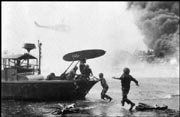WAR FILMS are about as old as the medium itself. Early newsreels recorded the Spanish-American War of 1898; by WWI, D.W. Griffith could shoot a jingoistic melodrama (Hearts of the World) near the trenches of France. WWII was the most cinematic of all global conflicts, with vivid documentary footage and directors like John Ford and John Huston ducking bullets to capture indelible scenes of horror and compassion. By the time of the Gulf War, our government had learned to produce its own polished, Hollywood images—thank you, CNN—although Three Kings (1999) already indicates a revisionist trend that may now collide with Dubya’s planned epic, the War on Terrorism.
The problem, as noted in these pages last week, is that this murky new conflict will likely defy easy narrative closure— unlike the notable war and anti-war movies alternating below. We can only wonder into which camp the new generation of 21st century war flicks will fall.
All Quiet on the Western Front: The 1930 treatment of Remarque’s WWI novel deservedly won the Best Picture Oscar. Still enormously affecting today, the film contributed to Depression-era isolationist feelings about distant European conflicts that only Pearl Harbor could end.
Saving Private Ryan: Spielberg’s expertly directed 1998 paean to the Greatest Generation is marred by a sentimental framing device, but the battlefield carnage is wrenchingly real. Though Tom Hanks’ infantry company is made up of types, their bewilderment in the face of arbitrary death rings true.
The Grand Illusion: Jean Renoir’s 1937 classic pits French captives against their German jailers during WWI but grants equal humanity to all.
Paths of Glory: Stanley Kubrick’s 1957 skewering of French incompetence during WWI features one of Kirk Douglas’ very finest performances; you can still feel his vein-throbbing outrage today.
From Here to Eternity: The movie that Pearl Harbor meant to be. Fred Zinneman’s 1954 adaptation of the James Jones novel garnered eight Oscars. Everyone remembers Burt Lancaster and Deborah Kerr tangled in the surf, but that erotic charge was all the more significant for the threat of death in combat tomorrow.
The Bridge on the River Kwai: David Lean’s 1957 WWII drama about Japanese prisoners forced to work for their captors took seven Oscars and sums up all the madness of war in the final, self-recriminatory words of Alec Guinness’ Col. Nicholson: “What have I done?”
The Birth of a Nation: Here’s a shock: The Ku Klux Klan are the good guys, and the South had the moral high ground during the Civil War. At least that’s the gospel according to D.W. Griffith’s epochal 1915 silent racist melodrama. The most technically accomplished film of its era, Nation made entertainment of war while still preserving a sense of its tragedy.
Dr. Strangelove: The Cold War produced several outstanding war movies (Fail-Safe and The Manchurian Candidate among them), but Stanley Kubrick’s madcap, pitch-black 1964 comedy of human stupidity and global annihilation takes the cake.
The Battle of San Pietro: John Huston’s 1945 documentary is only 33 minutes long, but its effect is overwhelming. Dog-tired GIs live and die (1,100 of them) to remove a small obstacle in the latter stages of WWII; Huston narrates the footage he shot while risking his own life.
Wag the Dog: Barry Levinson and David Mamet’s collaboration on this sly 1997 satire makes a phony media spectacle out of war—as some fear may happen with George W. Bush’s digital-age campaign.
The Green Berets: A terrible film but an important film, John Wayne’s 1968 pro- Vietnam War picture made possible the Rambo series, the career of Chuck Norris, and a lingering right-wing resentment—partially alleviated by the Gulf War—that our nation has an unsettled bit of Third World ass-kicking to do.
Apocalypse Now: Coppola’s 1979 ragged absurdist epic just returned with even more footage and folly as the three-hour, 16-minute Apocalypse Now Redux. Full of brilliant scenes and stunning images, it’s the best Vietnam movie made to date.
Top Gun: What war was Tom Cruise fighting, you ask? Uh . . . none, actually, but the empty-headed ’86 testosterone flick helped fuel Gulf War jingoism and the now obsolete notion of the precise, bloodless surgical strike. Make no mistake: After the World Trade Center bombing, boys will eagerly enlist and die because of this movie.








